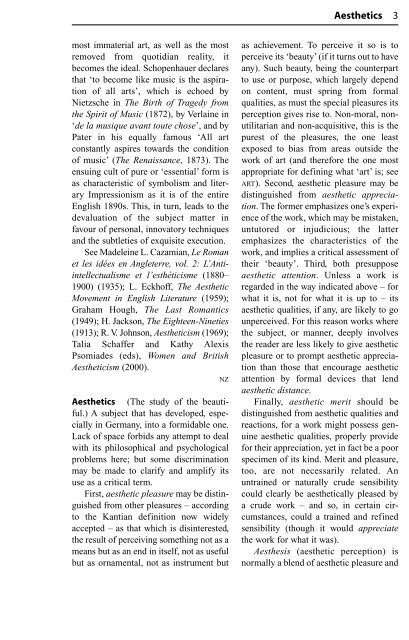The Routledge Dictionary of Literary Terms
The Routledge Dictionary of Literary Terms
The Routledge Dictionary of Literary Terms
You also want an ePaper? Increase the reach of your titles
YUMPU automatically turns print PDFs into web optimized ePapers that Google loves.
most immaterial art, as well as the most<br />
removed from quotidian reality, it<br />
becomes the ideal. Schopenhauer declares<br />
that ‘to become like music is the aspiration<br />
<strong>of</strong> all arts’, which is echoed by<br />
Nietzsche in <strong>The</strong> Birth <strong>of</strong> Tragedy from<br />
the Spirit <strong>of</strong> Music (1872), by Verlaine in<br />
‘de la musique avant toute chose’, and by<br />
Pater in his equally famous ‘All art<br />
constantly aspires towards the condition<br />
<strong>of</strong> music’ (<strong>The</strong> Renaissance, 1873). <strong>The</strong><br />
ensuing cult <strong>of</strong> pure or ‘essential’ form is<br />
as characteristic <strong>of</strong> symbolism and literary<br />
Impressionism as it is <strong>of</strong> the entire<br />
English 1890s. This, in turn, leads to the<br />
devaluation <strong>of</strong> the subject matter in<br />
favour <strong>of</strong> personal, innovatory techniques<br />
and the subtleties <strong>of</strong> exquisite execution.<br />
See Madeleine L. Cazamian, Le Roman<br />
et les idées en Angleterre, vol. 2: L’Antiintellectualisme<br />
et l’esthéticisme (1880–<br />
1900) (1935); L. Eckh<strong>of</strong>f, <strong>The</strong> Aesthetic<br />
Movement in English Literature (1959);<br />
Graham Hough, <strong>The</strong> Last Romantics<br />
(1949); H. Jackson, <strong>The</strong> Eighteen-Nineties<br />
(1913); R. V. Johnson, Aestheticism (1969);<br />
Talia Schaffer and Kathy Alexis<br />
Psomiades (eds), Women and British<br />
Aestheticism (2000).<br />
NZ<br />
Aesthetics (<strong>The</strong> study <strong>of</strong> the beautiful.)<br />
A subject that has developed, especially<br />
in Germany, into a formidable one.<br />
Lack <strong>of</strong> space forbids any attempt to deal<br />
with its philosophical and psychological<br />
problems here; but some discrimination<br />
may be made to clarify and amplify its<br />
use as a critical term.<br />
First, aesthetic pleasure may be distinguished<br />
from other pleasures – according<br />
to the Kantian definition now widely<br />
accepted – as that which is disinterested,<br />
the result <strong>of</strong> perceiving something not as a<br />
means but as an end in itself, not as useful<br />
but as ornamental, not as instrument but<br />
Aesthetics 3<br />
as achievement. To perceive it so is to<br />
perceive its ‘beauty’ (if it turns out to have<br />
any). Such beauty, being the counterpart<br />
to use or purpose, which largely depend<br />
on content, must spring from formal<br />
qualities, as must the special pleasures its<br />
perception gives rise to. Non-moral, nonutilitarian<br />
and non-acquisitive, this is the<br />
purest <strong>of</strong> the pleasures, the one least<br />
exposed to bias from areas outside the<br />
work <strong>of</strong> art (and therefore the one most<br />
appropriate for defining what ‘art’ is; see<br />
ART). Second, aesthetic pleasure may be<br />
distinguished from aesthetic appreciation.<br />
<strong>The</strong> former emphasizes one’s experience<br />
<strong>of</strong> the work, which may be mistaken,<br />
untutored or injudicious; the latter<br />
emphasizes the characteristics <strong>of</strong> the<br />
work, and implies a critical assessment <strong>of</strong><br />
their ‘beauty’. Third, both presuppose<br />
aesthetic attention. Unless a work is<br />
regarded in the way indicated above – for<br />
what it is, not for what it is up to – its<br />
aesthetic qualities, if any, are likely to go<br />
unperceived. For this reason works where<br />
the subject, or manner, deeply involves<br />
the reader are less likely to give aesthetic<br />
pleasure or to prompt aesthetic appreciation<br />
than those that encourage aesthetic<br />
attention by formal devices that lend<br />
aesthetic distance.<br />
Finally, aesthetic merit should be<br />
distinguished from aesthetic qualities and<br />
reactions, for a work might possess genuine<br />
aesthetic qualities, properly provide<br />
for their appreciation, yet in fact be a poor<br />
specimen <strong>of</strong> its kind. Merit and pleasure,<br />
too, are not necessarily related. An<br />
untrained or naturally crude sensibility<br />
could clearly be aesthetically pleased by<br />
a crude work – and so, in certain circumstances,<br />
could a trained and refined<br />
sensibility (though it would appreciate<br />
the work for what it was).<br />
Aesthesis (aesthetic perception) is<br />
normally a blend <strong>of</strong> aesthetic pleasure and

















